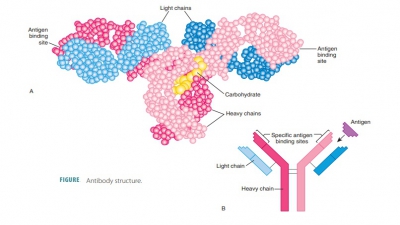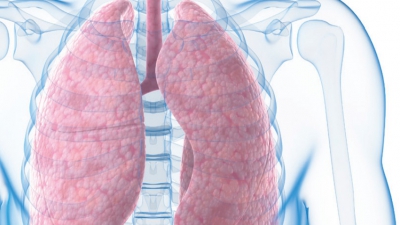Major Effector T Cells
| Home | | Anatomy and Physiology | | Anatomy and Physiology Health Education (APHE) |Chapter: Anatomy and Physiology for Health Professionals: Lymphatic System and Immunity
Activated T cells, similar to B cells, may become effector cells or memory cells. The three major types of effector T cells are helper, cytotoxic, and regulatory T cells.
Major
Effector T Cells
Activated T cells, similar to B cells, may become effector
cells or memory cells. The three major types of effector T cells are helper,
cytotoxic, and regulatory T cells.
Helper T Cells
Helper T
cells, abbreviated asTHcells, are central toadaptive immunity. They mobilize
both its humoral and cellular components. When activated by APC activity, TH cells help to activate
both B and T cells. They also “encourage” B and T cells to proliferate. Without
the aid of these “director” TH
cells, there will be absolutely no adaptive immune response. Their cytokines
provide chemical assistance require to recruit other immune cells. To
understand just how important the TH
cells are in immunity, consider what happens when they are destroyed, such as
in the con-dition known as AIDS.
There is direct interaction between TH cells and B cells that display antigen fragments
bound to class II MHC receptors. When a TH
cell binds to a B cell, the THcell
releases cytokines that encourage the B cells todivide more quickly. The TH cell then signals antibodyformation
to start. B cells continually divide as long as they are stimulated by TH cells. Therefore, TH cells help to release the
ability of B cells to protect the immune system.
Certain B cells are activated only when they bind to T cell-independent antigens. However,
responses to these antigens are usually weak and of short dura-tion. Most
antigens are T
cell-dependent antigens. They require T cell assistance in order to activate the B
cells that they bind to. Similar to B cells, CD8 cells usually need assistance
from TH cells in order to
acti-vate into destructive cytotoxic T cells. The TH cells cause dendritic cells to express surface
co-stimulatory molecules that are needed for CD8 cell activation.
Responses of the innate immune system are also increased by TH cells, such as when they
activate macro-phages to become more effective killer cells. Cytokines from TH cells mobilize lymphocytes
and macrophages, yet also attract other WBCs. As chemicals are released to
bring more cells to defend the body, the immune response increases. The amount
of immune elements can then overcome the antigens.
Three primary subsets of TH
cells are import-ant. They may develop during TH cell differentiation, based on which antigens are
present, and the locations in which they are encountered. Another factor is the
cytokine exposure of the differentiating TH
cell. The subsets are as follows:
■■ TH1 cells:These cells
control most components of cellular immunity. They stimulate inflammation,cause
activation of macrophages, and encourage differentiation of cytotoxic T cells.
■■ TH2 cells:They mostly
defend against parasitic worms and also promote allergies. They mobilize the
eosinophils and cause activation of immune responses depending on B cells and
formation of antibodies.
■■ TH17 cells: They releaseIL-17,which
helps link adaptive and innate immunity. This substance promotes inflammatory
responses that oppose extracellular microbes; these may be the cause of most
autoimmune diseases.
Cytotoxic T Cells
Cytotoxic
T cells are also calledactivated CD8 cells.They are abbreviated as TC cells, and are the only T cells that directly attack and kill
other types of cells. The body is patrolled by TC cells, which circulate through the blood and lymph, as well as
through the lymphoid organs. They search for cells with recog-nizable antigens.
They primarily target cells infected with viruses, but also attack tissue cells
infected with specific intracellular parasites or bacteria, cancer cells,
and foreign cells that may have been introduced via organ transplants or blood
transfusions.
In order to kill other cells, TC cells must bind to a self-nonself complex on the target cell.
Since all body cells display class I MHC antigens, TC cells can destroy all of them that are infected or abnormal.
Their attack upon foreign human cells, such as grafted cells, is not easily
understood since all of the antigens are nonself. They are probably able to
interpret foreign class I MHC antigens as a mixture of self class I MHC protein
that is bound to a foreign antigen.
When TC cells
recognize their targets, they uti-lize either perforins and granzymes, or they bind to specific membrane
receptors on target cells that stimulate apoptosis. Natural killer cells use
the same methods to kill target cells, but do not search for foreign antigens
displayed on class I MHC proteins. They instead search for other abnormalities
such as the lack of class I MHC or the presence of antibodies that coat the
target cell. A stressed cell often has a different surface marker that can
activate NK cells. Basically, NK cells find abnormal or foreign cells that TC cells cannot find.
Together, NK cells and TC
cells closely examine other cells for recognizable markers. This is known as immune surveillance. The NK cells search
foridentityflags, and class I MHC
proteins actually inhibit NK cellattack. However, the TC cells check these identity flags to determine whether they need
to be attacked. For example, foreign antigens stimulate attack by TC
cells.
Regulatory T Cells
Regulatory
T cells, abbreviated asTReg cells, arerelated to TH cells. They reduce the immune response
by either direct contact, or by the release of inhibitory cytokines. These
cells are important to prevent auto-immune reactions. They suppress
self-reactive lym-phocytes in peripheral tissues. This means that they act
outside lymphoid organs. The TReg
cells and their subtypes are under active research today. It is hoped that they
may be used in the future to cause tolerance to transplanted tissues, and to
reduce severity of auto-immune diseases.
1. Explain the actions of lymphocytes in cell-mediated
immunity.
2. Differentiate between the ways that lymphocytes and
antigen-presenting cells respond to antigens.
3. What are
the three major subtypes of T cells?
Related Topics


